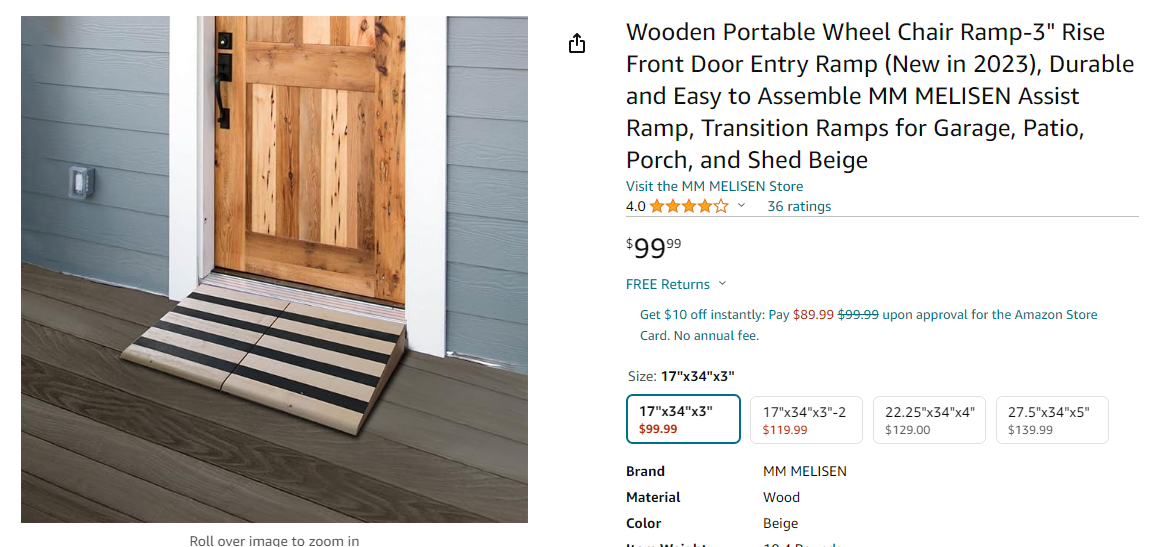Written by Emily Richardson.
Amazon has been inundated with orders for front door ramps. Why, you ask? Because these ramps are not just for accessibility anymore; they’re apparently being used as a makeshift barrier to keep federal agents at bay. Yes, the same ramps that were designed to help people navigate stairs are now a hot commodity in the battle against government bureaucracy.
It seems that Americans have discovered a novel way to use these ramps: blocking federal agents from entering their properties. As it turns out, the sturdy incline of a front door ramp is perfect for creating a physical obstruction. “We just figured if they can’t get through our front doors, they won’t bother us,” explained one delighted customer, who now views their front door ramp as a patriotic symbol of resistance.
The trend has caught on so quickly that Amazon is scrambling to keep up with demand. Ramps are flying off the virtual shelves faster than you can say “government intrusion.” The company, meanwhile, is reportedly considering expanding its selection to include even more barricade options, just in case this trend continues to rise.
The Federal Response: More Ramps, More Problems
Federal agencies have responded to this ramp revolution with a mixture of confusion and mild annoyance. According to sources, some agents have been forced to get creative, attempting to navigate these ramp barriers with various levels of success. “It’s a new kind of obstacle course,” said one agent, clearly exasperated. “Who knew our job would involve ramp negotiation?”
In a bid to address the issue, federal agencies have begun discussing alternative strategies for handling properties equipped with these makeshift barriers. One suggestion was to develop “ramp-proof” vehicles or perhaps invest in an arsenal of highly portable ramps to counter the growing trend. However, these plans remain in the early brainstorming stages, much to the chagrin of those on the front lines.
Meanwhile, the general public seems to find the whole situation rather entertaining. The notion that a simple piece of hardware could so effectively hinder government operations has become a source of amusement and pride. People are even starting to share photos and stories online about their ramp-related escapades, further fueling the trend.
The Ramping Up of Consumer Creativity
The phenomenon of using front door ramps as barriers has sparked an unexpected wave of consumer creativity. Some homeowners have started decorating their ramps with slogans and patriotic symbols, turning a simple accessibility aid into a statement of resistance. “My ramp is now decked out with stars and stripes,” said one enthusiastic ramp owner. “If the Feds want to get through, they’ll have to get past Uncle Sam first!”
Others are taking the trend even further, using their ramps to create elaborate obstacle courses complete with hurdles and mazes. “It’s like the American Ninja Warrior, but for federal agents,” joked another homeowner. This playful rebellion has taken on a life of its own, showcasing the inventive spirit of the average American facing bureaucratic challenges.
Despite the fun and games, it’s important to note that this trend might have some unintended consequences. As more people use their ramps to obstruct federal activities, it’s possible that these barriers could become a safety concern. After all, if the ramps are used to prevent agents from conducting their duties, what happens if they need to respond to an emergency?
Our Take: Why This Ramp Trend is More Than a Just Funny Quirk
So, what’s the final word on this ramp-related revolution? It’s a testament to the lengths people will go to in order to deal with perceived government overreach, but it’s also a sign of how a simple product can be repurposed in the most unexpected ways. While the creativity and humor involved in this trend are undeniably entertaining, the underlying issues are a bit more serious.
Using front door ramps to obstruct federal operations might be a clever workaround, but it also raises concerns about safety and security. If ramps are used to block essential government functions, it could lead to significant complications, particularly in emergency situations. Moreover, the trend reflects a deeper frustration with bureaucracy and government intrusion, highlighting the need for more effective communication and policy solutions.
Ultimately, while the ramp rebellion is a fascinating example of consumer ingenuity, it underscores the importance of addressing the root causes of discontent. It’s a reminder that while humor and creativity can provide temporary relief, they don’t replace the need for thoughtful and effective governance.\

